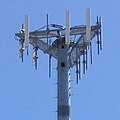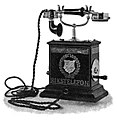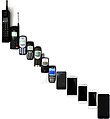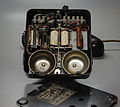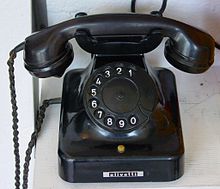
A telephone, colloquially referred to as a phone, is a telecommunications device that enables two or more users to conduct a conversation when they are too far apart to be easily heard directly. A telephone converts sound, typically and most efficiently the human voice, into electronic signals that are transmitted via cables and other communication channels to another telephone which reproduces the sound to the receiving user. The term is derived from Ancient Greek: τῆλε, romanized: tēle, lit. 'far' and φωνή (phōnē, voice), together meaning distant voice.
In 1876, Alexander Graham Bell was the first to be granted a United States patent for a device that produced clearly intelligible replication of the human voice at a second device. This instrument was further developed by many others, and became rapidly indispensable in business, government, and in households. (Full article...)

A mobile phone, or cell phone, is a portable telephone that allows users to make and receive calls over a radio frequency link while moving within a designated telephone service area, unlike fixed-location phones (landline phones). This radio frequency link connects to the switching systems of a mobile phone operator, providing access to the public switched telephone network (PSTN). Modern mobile telephony relies on a cellular network architecture, which is why mobile phones are often referred to as 'cell phones' in North America. (Full article...)
A smartphone is a mobile device that combines the functionality of a traditional mobile phone with advanced computing capabilities. It typically has a touchscreen interface, allowing users to access a wide range of applications and services, such as web browsing, email, and social media, as well as multimedia playback and streaming. Smartphones have built-in cameras, GPS navigation, and support for various communication methods, including voice calls, text messaging, and internet-based messaging apps. (Full article...)
Selected article -
The iPhone 6 and iPhone 6 Plus are smartphones that were developed and marketed by Apple Inc. They are the eighth generation of the iPhone, succeeding the iPhone 5, iPhone 5c and iPhone 5s, and were announced on September 9, 2014, and released on September 19, 2014. The iPhone 6 and iPhone 6 Plus jointly were themselves replaced as the flagship devices of the iPhone series by the iPhone 6s and iPhone 6s Plus on September 9, 2015. The iPhone 6 and 6 Plus include larger 4.7-inch and 5.5-inch displays, a faster processor, upgraded cameras, improved LTE and Wi-Fi connectivity and support for a near-field communications-based mobile payments offering.
The iPhone 6 and 6 Plus received positive reviews, with critics regarding their redesign, specifications, camera, and battery life as being improvements over previous iPhone models. However, aspects of the design of iPhone 6 were also criticized, including plastic strips on the rear of the device for its antenna that disrupted the otherwise metal exterior, and the screen resolution of the standard-sized iPhone 6 being lower than other devices in its class. The iPhone 6 sold extremely well, making it the best-selling iPhone model and the most successful smartphone to date.
The iPhone 6 and 6 Plus have been the subject of several hardware issues, including most prominently, being susceptible to bending under hard pressure (dubbed "Bendgate"), and as a byproduct of this lack of rigidity, the touchscreen's internal hardware being susceptible to losing its connection to the phone's logic board (nicknamed "Touch Disease"). Additionally, some iPhone 6 Plus models were the subject of camera issues, including some with malfunctioning optical image stabilization or otherwise defects on rear cameras. (Full article...)
Types of phones -

Field telephones are telephones used for military communications. They can draw power from their own battery, from a telephone exchange (via a central battery known as CB), or from an external power source. Some need no battery, being sound-powered telephones.
Field telephones replaced flag signals and the telegraph as an efficient means of communication. The first field telephones had a battery to power the voice transmission, a hand-cranked generator to signal another field telephone or a manually-operated telephone exchange, and an electromagnetic ringer which sounded when current from a remote generator arrived. This technology was used from the 1910s to the 1980s. Later the ring signal was operated by a pushbutton or automatically as on domestic telephones. Manual systems are still widely used, and are often compatible with the older equipment.
Shortly after the invention of the telephone, attempts were made to adapt the technology for military use. Telephones were already being used to support military campaigns in British India and in British colonies in Africa in the late 1870s and early 1880s. In the United States telephone lines connected fortresses with each other and with army headquarters. They were also used for fire control at fixed coastal defence installations. The first telephone for use in the field was developed in the United States in 1889 but it was too expensive for mass production. Subsequent developments in several countries made the field telephone more practicable. The wire material was changed from iron to copper, devices for laying wire in the field were developed and systems with both battery-operated sets for command posts and hand generator sets for use in the field were developed. The first purposely-designed field telephones were used by the British in the Second Boer War. They were used more extensively in the Russo-Japanese War, where all infantry regiments and artillery divisions on both sides were equipped with telephone sets. By the First World War the use of field telephones was widespread, and a start was made at intercepting them. (Full article...)
Selected audio -
A busy signal (or busy tone or engaged tone) in telephony is an audible call-progress tone or audible signal to the calling party that indicates failure to complete the requested connection of that particular telephone call. (Full article...)
List articles

- Comparison of smartphones
- List of best-selling mobile phones
- List of countries by number of broadband Internet subscriptions
- List of countries by number of telephone lines in use
- List of countries by smartphone penetration
- List of country calling codes
- List of iPhone models
- List of mobile network operators
- List of mobile phone brands by country
- List of mobile phone generations
- List of telecommunications companies
Related portals
General images -
Selected biography
Anthony Pollok (c. 1829 – July 4, 1898) was an American patent attorney who, with Marcellus Bailey, helped prepare Alexander Graham Bell's patents for the telephone and related inventions. (Full article...)
Selected images
Topics
Subcategories

More
 |
Here are some tasks awaiting attention:
|
Telephones in the news
- 4 January 2025 – Anglophone Crisis
- Gunmen from Nigeria kill at least five Cameroonian soldiers and injure several others in Bakinjaw, Southwest Region, Cameroon. (Reuters)
Associated Wikimedia
The following Wikimedia Foundation sister projects provide more on this subject:
-
Commons
Free media repository -
Wikibooks
Free textbooks and manuals -
Wikidata
Free knowledge base -
Wikinews
Free-content news -
Wikiquote
Collection of quotations -
Wikisource
Free-content library -
Wikiversity
Free learning tools -
Wiktionary
Dictionary and thesaurus





